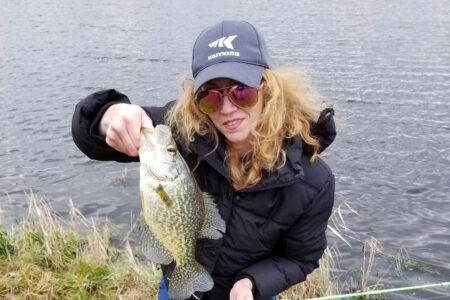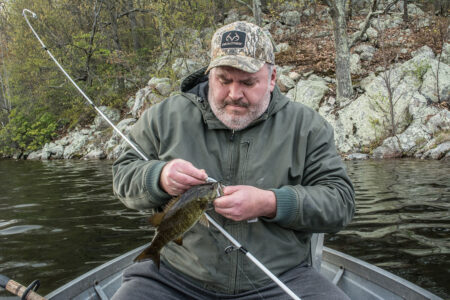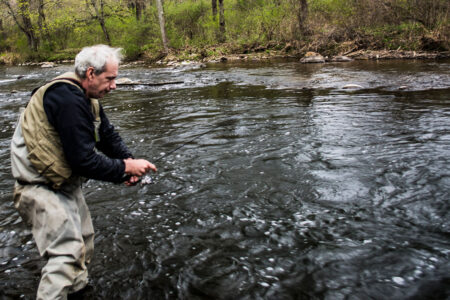During a warm rain in the fall, bass turn on and you can capitalize on the opportunity presented.
Early in the fall, we typically experience a rainstorm coming from the south bringing warm temperatures. By late September or early October, water temps will have slid below 70, and though bass actively chase forage, a slight temperature rise helps stimulate an especially good bite. What a barometer can indicate matters even more, but finding the sweet spot of a deep drop in pressure is hit or miss.
I experienced a bass blitz in 1976, which involved a tornado watch and close lightning. A fiberglass rod helped protect me. Fiberglass won’t conduct electricity as graphite rods do, but even if you do own a fiberglass rod, I don’t recommend you follow the example of a rash 15-year-old. The bass did go insane, actually leaping out of the water to land on top of my buzzed spinnerbait – and getting hooked. I caught 32 of them: four over 3 pounds, one of those nearly 4 pounds.
Another occasion proved an exceptional catch doesn’t necessarily depend on an electrical storm. I fished early in the fall, temps in the mid-70s, buckets of rain coming down with no lightning. A pond yielded 12 bass in 45 minutes where normally I have to work hard to catch three or four in a couple hours. My time was limited that afternoon, and I wonder what a two-hour score would have been.

If you’re in the habit of interpreting barometer readings, you know better than I do. I’ve never paid attention to them, but I’ve fished storms when I’ve suspected the pressure wasn’t right. On those occasions, I haven’t done so well. On others, I’ve seemed to feel directly if a storm is ugly enough for fierce action, and I’ve done better. You can always test the situation either way by getting out and fishing.
My fall storm experience is limited to ponds, but lakes and reservoirs will turn on, too. Wherever you fish, the first spot to consider should be a flooded feeder stream, if one is available. Especially the edges between muddy influx and clear water will produce, but sometimes you’ll hook a bass where it can sense a spinnerbait only by its lateral line.
You’ll also find plenty of bass anywhere else in the shallows. Whether along shorelines or on top of shallow flats, they’ll be chasing down fish forage. If you fish a pond, make sure to cast parallel to the bank without spending too much time at one spot. Give a pond “the once over” by progressing along the bank, making sure not to miss any shallow water adjacent to it, until you return to where you started. Naturally, if you know the whereabouts of additional shallows—flats are a common example—you’ll save time over what it will take to search them out. The idea is to cover water quickly, and if you have the time, you can car-hop to additional ponds.
Spinnerbaits serve the purpose. Active bass will slam topwater plugs, but don’t slow down. The action is fast. A Whopper Plopper is a good one to retrieve fast. Buzzbaits will work, too, but I can’t think of a better time to buzz spinnerbait blades at the surface on quick retrieves. Jerkbaits retrieved quickly will also work. It’s easy to imagine a sinking Rapala Countdown retrieved at top speed getting hit. If you begin the retrieve as soon as the plug touches down, it will work in the shallows, but I will stick to my spinnerbaits. They never fish better than they do now.
Quarter-ounce to half-ounce, if you’re fishing a larger spinnerbait, casting gear is ideally suited, and if you can achieve the pinpoint accuracy casting gear is known for, you’ll enjoy taking advantage of any brush in the water or configurations of weeds. Bass are on the move during these storms, but you can still expect them to take ambush positions. If you have spinning gear instead, it’s not a problem.
Bass over eight pounds lurk in the big lakes and reservoirs, but little ponds of a few acres often hide a 5-pound lunker. It’s an elusive fish that gets that big, partly because it evades the hooks of people like you. During a warm rain in the fall, it might lose inhibition.



